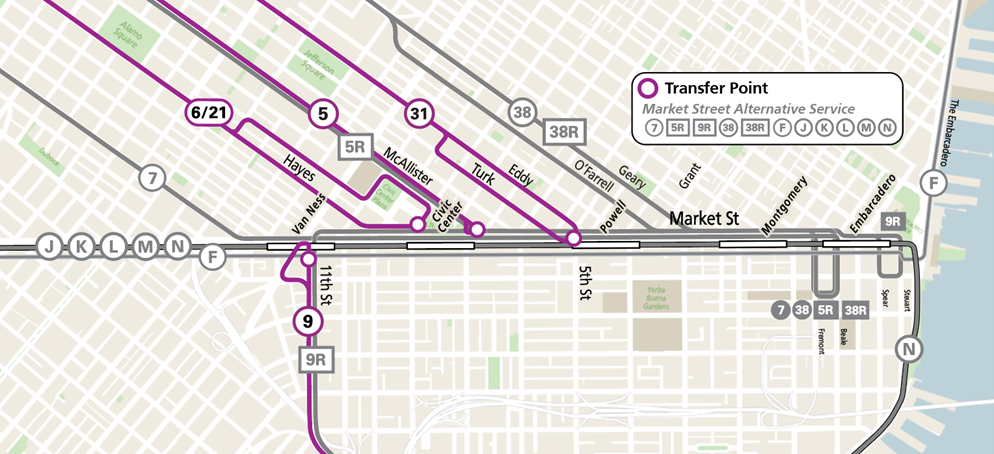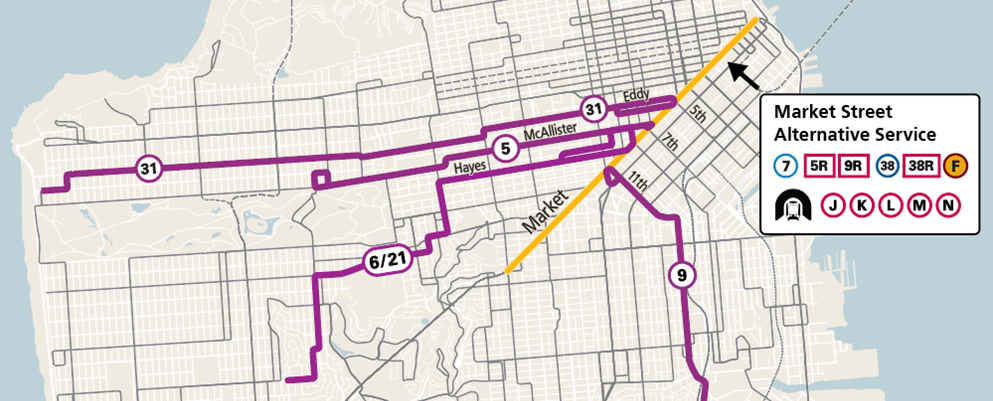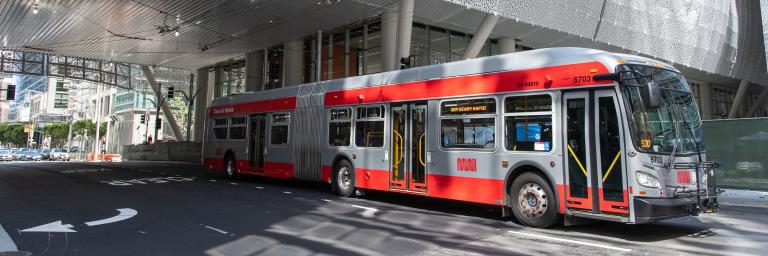Muni service cuts are expected this summer. We never want to cut Muni service. But if we are forced to make a cut this summer because of our financial crisis, we’re determined to do it in a way that protects Muni riders as much as possible. Beginning in July, we won’t be able to afford to replace transit operators, maintenance or cleaning staff.
We received extensive feedback in winter 2025 on three approaches we could take to make these cuts. We listened to community members’ feedback and developed a plan that would minimize the impacts on our customers as much as possible. We thank all those who reached out to us. We understand how much our Muni service means to you.
Below is a proposal that is based on the comments we received. We shared this proposal at our Board of Directors’ meeting on March 18. At that meeting, our Board directed staff to proceed with the proposed service plan.
Service cuts are currently expected to take effect on June 21.
Why we may have to cut Muni service
We’re facing a $50 million budget shortfall because parking revenue, transit revenue and General Fund reimbursements are lower than we’d expected. This is largely a result of the pandemic and its economic impact.
We’ve increased transit fare enforcement, cut spending, become more efficient and paused most hiring. But it’s still not enough to close the gap in our July 2025 to June 2026 budget.
We won’t be able to afford to replace transit operators, maintenance or cleaning staff starting in July. So, in summer 2025, we’ll have to cut Muni service by about 2%, which will save about $7 million. We’ll make up the remainder of the $50 million in other ways, including improving fare compliance and optimizing our parking programs.
Taking advantage of abundant service to maintain connections and frequency
After presenting to our Board of Directors Feb. 4 three possible approaches we could take to make service cuts, we collected public feedback (summarized below) on how we could minimize the impact of potential service cuts. That feedback informed the service plan proposal below. This plan would result in a smaller service cut than what was presented to our Board in February (a service reduction of about 2% instead of about 4%). This is half as many cuts as we originally thought we’d need and will be far less disruptive. This service plan would maintain all connections and frequency and take advantage of the transit-rich Market Street corridor.
To help address our funding shortfall, three routes that run along or cross Market St would be shortened on weekdays, and two other routes would be consolidated on both weekdays and weekends.
The three routes to be shortened, the 5 Fulton, 9 San Bruno and 31 Balboa, would turn around to go back outbound once they reach Market Street. Riders would then be able to transfer to the lines that will remain on Market Street.
The 5R Fulton Rapid and 9R San Bruno Rapid would remain in service. During evenings and weekends when the 5R Fulton Rapid and 9R San Bruno Rapid don’t currently operate, the 5 Fulton and 9 San Bruno would continue service on Market Street to their current terminals.
6 Haight-Parnassus and 21 Hayes would be combined into one line with the portion of the 6 Haight-Parnassus west of Masonic Avenue and the portion of the 21 Hayes east of Masonic Avenue.
On Market Street, under the proposed service plan, Muni buses and trains together will provide service about every three or four minutes on weekdays east of Van Ness Avenue. Additionally, in the subway along Market Street, the five Muni Metro lines together provide service every two minutes on weekdays.
This proposal will maintain the connections to Market Street while also reducing resources so we can maintain both service coverage and frequency where ridership is the highest.
Service Plan Overview
-
5 Fulton would turn around at McAllister & Market/Civic Center Station on weekdays; 5R Fulton Rapid would remain as-is
-
9 San Bruno would turn around at 11th & Market Street/Van Ness Station on weekdays; 9R San Bruno Rapid would remain as-is
-
31 Balboa would run between Cabrillo & La Playa and 5th & Market/Powell Station (current weekend route). Riders could continue to Caltrain on the 30 Stockton, 45 Union/Stockton or T Third.
-
6 Haight-Parnassus and 21 Hayes would be combined into one line with portions of each and turn around at Hyde & Market/Civic Center Station.
-
This new route would serve all current 6 Haight-Parnassus stops west of Masonic Avenue. Riders who typically use 6 Haight-Parnassus stops east of Masonic Avenue could instead use 7 Haight-Noriega service.
-
The route would also serve all current 21 Hayes stops east of Masonic Avenue. Riders who typically use 21 Hayes stops west of Masonic Avenue could use 5 Fulton or 5R Fulton Rapid service two blocks away.
-

A map showing where routes would turn around at Market Street under a new proposal to save funds by reducing duplicate Muni service.

A map showing the proposed routing of a new route that would combine the 6 Haight-Parnassus and 21 Hayes.
What to expect and how to share your feedback
- Tuesday, April 1
- Tuesday, April 1: We expect our Board to meet and further consider whether to move forward with the currently proposed Muni service cuts. We invite you to attend the April 1 meeting in person. Free language assistance is available with 48 hours’ notice prior to the meetings. Before the meeting, you can also share your feedback by emailing MTABoard@SFMTA.com and cc: MuniCuts@SFMTA.com or call 415.646.2005 by Monday, Mar. 31, 12 p.m. to ensure your comment is received by the Board in advance of the meeting. See Apr. 1 meeting webpage for details.
-
Tuesday, April 15 (Tentative):
-
If the direction on April 1 is to move forward with implementing the service cuts proposal, the Board will vote on the item at the April 15 meeting. These meetings are open to the public. Free language assistance is available with 48 hours’ notice prior to the meetings. Before the meeting, you can also share your feedback by emailing MTABoard@SFMTA.com and cc: MuniCuts@SFMTA.com or call 415.646.2005 by Monday, Apr. 14, 12 p.m. to ensure your comment is received by the Board in advance of the meeting. See Apr. 15 meeting webpage for details.
-
-
Spring 2025: Extensive public outreach will be done to familiarize riders with changes they can expect to their trips starting June 21. To request a presentation, for more information or language assistance, contact MuniCuts@SFMTA.com or 415.646.2005.
-
June 21, 2025: We expect to implement the service changes described above.
Please continue to check back on this page for updates.
How community feedback informed the proposal
In winter 2025, we prepared three potential approaches for expected cuts to Muni service. We used these potential approaches to collect feedback on what our riders want us to prioritize so that we could minimize impacts to communities across the city. They:
-
Prioritized maintaining frequency on high ridership routes
-
Maintained existing connections, or
-
Preserved service on routes serving neighborhoods identified through our Muni Service Equity Strategy through a hybrid of maintaining frequency and connections.
Overwhelmingly, the feedback we heard was to not cut Muni service. There was not consensus on whether to prioritize maintaining frequency or maintaining connections. We recognize these are difficult choices.
Outreach to Collect Feedback
To collect feedback on how best to cut Muni service with minimum impact, we:
-
Hosted a multilingual hotline at 415.646.2005 and MuniCuts@SFMTA.com
-
Hosted ten pop-ups at major transit transfer points citywide, and ridealongs on the 5 Fulton and 9 San Bruno with staff who speak English, Cantonese, Mandarin and Spanish
-
Posted 600+ posters requesting feedback in nine languages. The posters were posted at Muni stops on ten Muni routes that would be impacted by possible service cuts
-
Digital public service announcements, or PSAs, were displayed in transit shelters citywide
-
This webpage continues to be updated with the latest information. From Feb. 4 through Feb. 25, this page featured a video with subtitles and a feedback form to collect feedback in English, Traditional Chinese, Spanish and Filipino (see Related Content to view the video).
-
Email and text messages were sent to Muni Alerts subscribers and community-based organizations offering briefings
-
Presentations were made to the Board of Directors Feb. 4 and Mar. 18, the SFMTA Citizens’ Advisory Council on Feb. 6 and Mar. 6 and Muni Equity Working Group on Jan. 23 and Feb. 11
At the Mar. 18 meeting, the Board had before them the choice to take service cuts off the table and look at other sources to bridge the $7M gap or to proceed with the service cut proposal. The Board opted to move forward with the service cuts proposal for further consideration.
A presentation of the final service cuts proposal and results of the federally required service equity analysis is planned for our Board meeting on April 1. The April 1 meeting has been noticed as an additional opportunity for public comment. If the direction on April 1 is to move forward with implementing the service cuts proposal, the Board will vote on the item at the April 15 meeting.
How does the SFMTA make decisions about Muni service?
We know that Muni service is a lifeline for many. Quality public transportation is also key to San Francisco achieving its climate, equity and economic recovery goals. So, we don't take making changes to Muni service lightly. When we make changes to service we aim to:
-
Maintain the highest possible quality service to the nine neighborhoods identified by our Muni Service Equity Strategy and on the routes heavily used by seniors and people with disabilities
-
Provide service coverage to locations with trip generators, such as hospitals, grocery stores, and commercial, cultural, and employment centers
-
Retain access to opportunities including schools and workplaces
-
Consider ridership demand (crowding) and frequency
-
Consider feedback from customers, operators and policymakers
-
Support economic recovery
-
Consider cost per rider
How is this different from Muni Funding Working Group proposals?
These near-term changes reflect our current budget, staffing and vehicle availability. To provide riders service that is reliable, we aim to only schedule Muni service that we have the resources to operate. Since we have paused most hiring due to our financial situation, when staff leave the agency, we are forced to reduce service accordingly.
The Muni Funding Working Group service cut proposals are 10 times bigger in scale than what we are proposing for 2025. The Muni Funding Working Group proposals are an illustration of the types of cuts we’d be forced to make, not a proposal or plan for cuts, and we urgently hope it doesn’t come to that.
